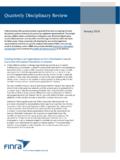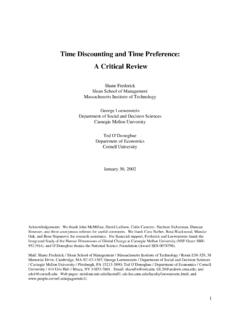Transcription of A Review of Research done on Tomatis Auditory …
1 Jan Gerritsen, 2009, page1A Review of Research done on Tomatis Auditory StimulationJan Gerritsen, PhDAbstractA total of 35 studies were published on the impact of the Tomatis Method of Auditory largest number of publications deals with treating learning disabilities, showing that a variety oflearning disabilities are effectively treated by the Tomatis Method. Several small scale researchprojects on autism have been reported, showing that about 60% of the autistic children benefit fromthe Tomatis studies show that the Tomatis intervention accelerates the learningof foreign languages. One of these shows that the Tomatis intervention reduces the time to obtain acorrect pronunciation by half. Two small scale study documents the positive impact of TomatisTraining on the voice. Other studies show that Tomatis Training facilitates child birth and reducesthe time of labor. Other studies show positive effects on stuttering, retardation and on a range ofpsychological paper reviews the Research done on theimpact of the Tomatis Method of auditorystimulation.
2 For an in-depth overview of theTomatis Method, please see Pierre Sollier s: ListeningforWellness (Sollier,2005).The Tomatis Method of Auditory stimulationutilizesmusicthathasbeenelect ronicallymodulated by a device of Tomatis design, calledthe Electronic Ear. The resulting sound ispresented through headphones and vibrators. It hasto be emphasized that the Tomatis Electronic Earhas evolved over the years. In the early 70 s boneconduction was introduced to more effectivelystimulate the Auditory pathways. Later-on, theextended precession was introduced. In the late90 s, new gating systems were introduced allowingto change both the slope and the pivot point of thegating system. All these improvements helped toincrease the success rate of the Tomatis treatment modalities have also changed overthe years, most notably using channel reversalwhen called for. Also, in the case ofautism, thenumber of hours of listening to a recording of themother'svoicehasincreasedsignificantl y,improving the success rate to 80% (Vervoort,2006).
3 The current theory is that Tomatis Methodstimulatesthemyelinationoftheaudit orypathways (Sacarin, 2009) which improves thespeed of processing of the Auditory signals(Kandel, 2000).In addition, the auditorystimulation results in a better integration betweenthe different sensorial systems and in a moreharmonious balance between the para-andsympathetic nerve system ( Tomatis , 1983).Inmanycases,theTomatistreatmentisa ccompanied by other forms of therapy. In the caseof treating learning disabilities, sensory integrationexercises have been shown to be useful has also to be emphasized that the results dependalso on the skill of the Tomatis practitioner. Theconcept of "the machine does it all" is definitelynot valid for the Tomatis Method. Carefulobservation of the client, adjusting the settings onthe Electronic Earaccordingly and psychologicalcounseling (of the client and if we are dealing witha child, also of the parents) are integral parts of theTomatis the patents covering the Electronic Ears havelapsed, several forms Auditory stimulation arebeing marketed, many of which make reference tothe Research done on the Tomatis Method.
4 Whilesome of these Methods might or might not havebeneficial effects, the Research discussed belowcannot be used to support their claims. Todetermine whether the Auditory program meets theTomatis criteria, please consider the following: Jan Gerritsen, 2009, page2 Is the program administered by a trainedTomatis practitioner who has obtained atleast 4 weeks of full time training? Is the progress monitored by administeringregular Listening Tests, so as to adjust theprogram and the settings on the ElectronicEar? What is the duration of the therapy? Foroptimal results, the length of the programneeds in most cases to be between 60 and75 hours, much longer in case of autism. Does the program include reading textsinto a microphone connected to theElectronic Ear, an essential part of theTomatis protocol? Does the program include listening to arecording of the Mothers Voice (ifavailable) via the Electronic Ear, again anessential part of theTomatis Review covers Research done in the followingareas: Auditory Processing Disorders Learningdisabilitiesand Behavior Problems Attention Deficit Disorders Autism Learning Foreign Languages Voice Child Birth Stuttering Psychological DisordersAuditory Processing DisordersThe current hypothesis is that Auditory ProcessingDisorders are the root cause of many learning andbehavior problems.
5 Tomatis Auditory Stimulationis believed to stimulate the myelination of theauditory pathways and so improve the speed ofprocessing of the Auditory signals (Sacarin, 2009).To check this theory,Ross-Swain(The SwainCenter, Santa Rosa, California) reviewed the pre /post treatment testing results of 41 randomlyselected clients that had Auditory ProcessingProblems (Ross-Swain, 2007).The subjects (18 females, 23 males) ranged in agefrom years to years (mean age of ).All subjects received 90 hours of Tomatis auditorystimulation, and were not receiving any othertherapy at the time. The effect of the treatment wasmeasured using the TAPS (Test of AuditoryPerceptual Skills) and the TCC (Token Test forChildren). The post study was done eight to twelveweeks following the TAPS measures a variety of auditoryresponses. Auditory Discrimination is theprocess used to discriminate among sounds ofdifferent frequencies, duration or intensity.
6 Aproblem with Auditory discrimination can affectreading, spelling and writing skills. AuditoryMemory refers to the recall of an acoustic problem in this respect may affect memorizationskills. Auditory Processing (also referred to asauditory cohesion) is the ability to interpret,organize and synthesize Auditory information on ahigher-order level of functioning. These skills arenecessary for listening comprehension, abstractreasoning and problem solving. Interpreting andFollowing Directions is a skill that depends onthe Auditory skills discussed above. It is one sability to comprehend, understand and interpretauditory information well enough to TAPS results are given in Table 1. The lastcolumn shows the pre / post percentile between 37% and 68% denote an averageperformance. Scores falling below 37% is belowaverage and scores above 68% are considered tobe above average.
7 Prior to the treatment, of the Tomatis Auditory stimulation ,the scores were in the average range and thus, onaverage, the clients no longer had auditoryprocessing problems. In addition, a significantreduction in Auditory latency was also noted (63%to 39%).TAPS subtestsPre / Post% Auditory / / Memory, / Memory,digits / Memory, / Memory, / / / 1: Ross-Swain study:Pre/Post Percentile RatingsThe TokenTest of Children, which measures achild s ability to follow spoken directions, showed Jan Gerritsen, 2009, page3significant increases in both Age and GradeScores. The average Age Score increased from 486to 500 and the average Grade Score from 486 to499. This shows that Tomatistherapy helpschildren to better comprehend, remember andexecute (dis)abilitiesandBehaviorProblemsThe Tomatis Method has been found to beeffective in the treatment of learning difficultiesand behavior total of 10studies wereconducted.
8 All except one showed positive effectsof the Tomatis Method of Auditory analyzing the data, mainly percent changesin the pre/post scores are reported, so as to correctfor differences in the pretest scores between thetest and control group. The data which aresignificant at a 95% or higher confidence level arelabeled with an s .Rourkeet al(University of Windsor, Ontario,Canada) studied 25 learning disabled childrenfrom nine to fourteen years of age, following themover a period of one year (Rourke, 1982). Sixteenfollowed the Tomatis program and nine wereassigned to the control group. The subjects werenot randomly assigned but were balanced forinitial IQ. Most of the subjects were enrolled inschoolsfor children with learning disabilities orreceived supplementary special education ortutoring. The report did not mention the number ofhours of Auditory stimulation nor the length of subjects were assessed on a battery ofstandardized test, some administered at 3 monthsintervals, others just at the beginning of theresearch and after 1 year.
9 The test battery includedthe Wechsler Intelligence Scale for Children(WISC,Wechsler,1949),thePersonal ityInventory for Children (PIC, Wirt, 1977, whichassesses the opinion of the parents on the child sbehavior attitudes and family relationships), theWide Range Achievement Test (WRAT, Jastak &Jastak, 1965), the Verbal Fluency Test (Strong,undated), the Oral Reading Test (Gates &McKillop, 1962) and the Grooved Pegboard Test(GPT, Klove, 1963, a measure of speed andaccuracy of hand-eye coordination).Table 2 summarizes the key results, all of whichwere either directionally or significantly in favorof the Tomatis intervention (negativechanges inthe PIC and GPT scales denote improvements).Tom/ CtrlN16/ 9 WISC, Full Scale IQ+5/ 0, sWISC, Verbal IQ+2/-2 WISC, Performance IQ+8/ +2, sPIC, Adjustment Scale-16/-2, sWRAT Reading +6/+2, sWRAT Arithmetic +2/-3 Verbal Fluency+27/ +11 Oral Reading+35/ +21 GPT, Dominant Hand Score-18/-7, sTable2:Rourke Study, % ChangeThere were no instances where the performance ofthe control group advanced at a significantlygreater speed, or to a significantly higher levelthan the treatment al(North Shore University Hospital,Cornell University, ) studied 26 language-impaired preschool children over a period of ninemonths (Wilson, 1982).
10 Eighteen received Tomatisauditory stimulation plus the Wilson remedialprogram and eight were assigned to the controlgroup, which only received the Wilson Research had shown that the WilsonProgram was effective in helping languageimpaired children. The report did not mention thenumber of hours of Auditory stimulation nor thelength of the test battery included the WIG, a test in whichparents and teachers rate the subjects in terms of awide spectrum of distinct behavioral test was specifically designed for this additions it included a non specified testmeasuring Auditory closure and sound 3 summarizes the key results. They showthat the children in the treatment group exceededthe performance of those in the control group,either significantly or directionally, in terms ofcommunication, Auditory closureandsoundmimicry: Jan Gerritsen, 2009, page4 Tom / CtrlN18 / 8 WIG Communication ScoresParent s rating22 / 12 Teacher s rating34 / 27 Language DomainSound Mimicry86 /-9, sAuditory Closure38 / 3 Table3:Wilson Study, % ChangeBased on observations of parents and teachers, thechildren in both groups significantly improved incommunication skills.






